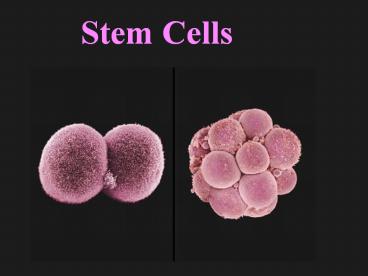Stem Cells - PowerPoint PPT Presentation
1 / 35
Title:
Stem Cells
Description:
Stem Cells Why the Controversy Over Stem cells? Embryonic Stem cells are derived from extra blastocysts that would otherwise be discarded following IVF. – PowerPoint PPT presentation
Number of Views:1710
Avg rating:3.0/5.0
Title: Stem Cells
1
Stem Cells
2
Importance of Stem Cell Research
3
Stem Cell History
1998 - Researchers first extract stem cells from
human embryos 1999 - First Successful human
transplant of insulin-making cells from
cadavers 2001 - President Bush restricts federal
funding for embryonic stem-cell research 2002 -
Juvenile Diabetes Research Foundation
International creates 20 million fund-raising
effort to support stem-cell research 2002 -
California ok stem cell research 2004 - Harvard
researchers grow stem cells from embryos using
private funding 2004 - Ballot measure for 3
Billion bond for stem cells
4
Stem Cell Definition
- A cell that has the ability to continuously
divide and differentiate (develop) into various
other kind(s) of cells/tissues
5
Stem Cell Characteristics
- Blank cells (unspecialized)
- Capable of dividing and renewing themselves for
long periods of time (proliferation and renewal) - Have the potential to give rise to specialized
cell types (differentiation)
6
Kinds of Stem Cells
Stem cell type Description Examples
Totipotent Each cell can develop into a new individual Cells from early (1-3 days) embryos
Pluripotent Cells can form any (over 200) cell types Some cells of blastocyst (5 to 14 days)
Multipotent Cells differentiated, but can form a number of other tissues Fetal tissue, cord blood, and adult stem cells
7
Pluripotent
Multi- potent
Fully mature
8
Kinds of Stem Cells
- Embryonic stem cells
- five to six-day-old embryo
- Tabula rasa
- Embryonic germ cells
- derived from the part of a human embryo or fetus
that will ultimately produce eggs or sperm
(gametes). - Adult stem cells
- undifferentiated cells found among specialized or
differentiated cells in a tissue or organ after
birth - appear to have a more restricted ability to
produce different cell types and to self-renew.
9
Pluripotent Stem Cells more potential to become
any type of cell
10
Multipotent stem cells
- Multipotent stem cells limited in what the
cells can become
11
Embryonic Stem Cells
Mainly from IVF
12
Sexual Reproduction
13
Stages of Embryogenesis
cleavage
8-cell stage
blastocyst
Blastocyst inner mass cells
14
Blastocyst Diagram
15
Adult Stem Cells
An undifferentiated cells found among specialized
or differentiated cells in a tissue or organ
after birth
- Skin
- Fat Cells
- Bone marrow
- Brain
- Many other organs tissues
16
Induced Pluripotent Stem Cells
17
Bone Marrow
- Found in spongy bone where blood cells form
- Used to replace damaged or destroyed bone marrow
with healthy bone marrow stem cells. - treat patients diagnosed with leukemia, aplastic
anemia, and lymphomas - Need a greater histological immunocompatibility
18
Blood Cell Formation
19
Umbilical cord stem cells
- Also Known as Whartons Jelly
- Adult stem cells of infant origin
- Less invasive than bone marrow
- Greater compatibility
- Less expensive
20
Umbilical cord stem cells
- Three important functions
- Plasticity Potential to change into other cell
types like nerve cells - Homing To travel to the site of tissue damage
- Engraftment To unite with other tissues
21
Stem Cell Applications
- Tissue repair
- - nerve, heart, muscle, organ, skin
- Cancers
- Autoimmune diseases
- - diabetes, rheumatoid arthritis, MS
22
Tissue Repair
- Regenerate spinal cord, heart tissue or any other
major tissue in the body.
23
Replace Skin
http//www.youtube.com/watch?featureplayer_embedd
edveXO_ApjKPaI
24
Heart Disease
- Adult bone marrow stem cells injected into the
hearts are believed to improve cardiac function
in victims of heart failure or heart attack
25
(No Transcript)
26
Leukemia and Cancer
- Studies show leukemia patients treated with stem
cells emerge free of disease. - Injections of stem cells have also reduces
pancreatic cancers in some patients.
Proliferation of white cells
27
Rheumatoid Arthritis
- Adult Stem Cells may be helpful in jumpstarting
repair of eroded cartilage.
28
Type I Diabetes
- Pancreatic cells do not produce insulin
- Embryonic Stems Cells might be trained to become
pancreatic islets cells needed to secrete
insulin.
29
Stem cells in the adult brain
30
new research reprogramming cells
31
Technical Challenges
- Source - Cell lines may have mutations.
- Delivery to target areas
- Prevention of rejection
- Suppressing tumors
32
Problems with Adult Stem Cells
Mutations can lead to leukemia
33
Why is Stem Cell Research So Important to All of
Us?
- Stem cells can replace diseased or damaged cells
- Stem cells allow us to study development and
genetics - Stem cells can be used to test different
substances (drugs and chemicals)
34
Why the Controversy Over Stem cells?
- Embryonic Stem cells are derived from extra
blastocysts that would otherwise be discarded
following IVF. - Extracting stem cells destroys the developing
blastocyst (embryo). - -Questions for Consideration-
- Is an embryo a person?
- Is it morally acceptable to use embryos for
research? - When do we become human beings?
35
(No Transcript)































